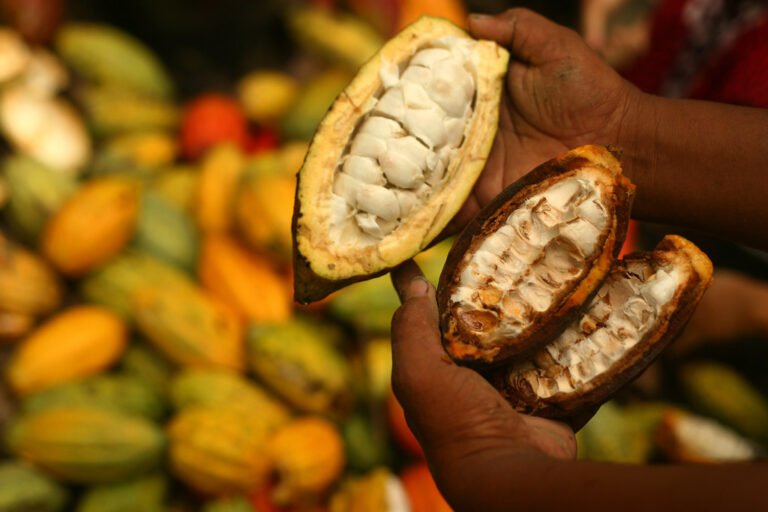As a critical ingredient in chocolate production, cocoa farming is essential to the global food industry. However, cocoa farming also significantly impacts the environment and local communities. In this article, we will take a comprehensive look at the benefits and challenges of cocoa farming, exploring the science behind the process and its impact on the environment and local communities.
The Science of Cocoa Farming
Cocoa farming is cultivating the cocoa tree, a small evergreen tree native to tropical regions of Central and South America. The cocoa tree produces large, pod-shaped fruits, each containing between 20 and 60 cocoa beans. These beans are then processed and used to make cocoa powder, chocolate, and other cocoa-based products.
The cultivation of cocoa trees requires a specific set of conditions, including tropical temperatures, high humidity, and abundant rainfall. Cocoa trees also need well-drained, nutrient-rich soil to grow, making them well-suited for the regions in which they are traditionally grown.

Benefits of Cocoa Farming
Cocoa farming provides a range of benefits to both farmers and consumers. For farmers, cocoa farming offers a source of income and employment, helping to support local economies in many regions of the world. The global demand for cocoa also allows farmers to sell their products worldwide, potentially increasing their earning potential.
In addition to the economic benefits, cocoa farming has also been linked to various environmental benefits. Cocoa trees are often grown alongside other crops, such as bananas, providing a form of agroforestry that can help to improve soil quality and promote biodiversity.
Consumers also benefit from cocoa farming, with cocoa and chocolate being an essential part of many diets and a popular treat worldwide. In addition to the enjoyment of consuming chocolate, some studies have also suggested that cocoa may have various health benefits, such as reducing the risk of cardiovascular disease.
Challenges of Cocoa Farming
Despite the many benefits of cocoa farming, the industry faces various challenges. One significant challenge is the impact of cocoa farming on the environment. Expanding cocoa farms into previously forested areas can lead to deforestation and habitat loss, with significant environmental impacts.
Cocoa farming also relies heavily on pesticides and fertilizers, which can negatively impact the environment and the health of farmers and local communities. Additionally, the low wages paid to many cocoa farmers and the prevalence of child labor in the industry are significant challenges that must be addressed.

Sustainable Cocoa Farming
Many organizations and companies are working to promote sustainable cocoa farming practices to address these challenges. These practices aim to reduce the negative impact of cocoa farming on the environment and local communities while promoting the industry’s economic benefits.
Sustainable cocoa farming practices can include agroforestry techniques, organic and natural pest control methods, and promoting fair trade practices that ensure farmers receive fair wages for their products. These practices can help promote a more sustainable and equitable cocoa industry, benefiting both farmers and consumers.
Conclusion
Cocoa farming is a critical industry providing many benefits to farmers and consumers. However, the sector faces significant challenges, including environmental impacts and social justice issues. By promoting sustainable cocoa farming practices, we can work to address these challenges and promote a more sustainable and equitable industry for all involved.
FAQ’s
- What is cocoa farming, and where is it typically grown? Cocoa farming is cultivating the cocoa tree, a small evergreen tree native to tropical regions of Central and South America. Today, cocoa, including in West Africa, South America, and Southeast Asia, is grown worldwide.
- What are the benefits of cocoa farming? Cocoa farming provides many benefits, including providing a source of income and employment for farmers and supporting local economies. Additionally, cocoa is a popular ingredient in many food products, and some studies suggest that it may have various health benefits.
- What are the challenges of cocoa farming? Cocoa farming faces many challenges, including environmental impacts such as deforestation and habitat loss, as well as social justice issues related to low wages and child labor in the industry.
- What are sustainable cocoa farming practices? Sustainable cocoa farming practices aim to reduce the negative impact of cocoa farming on the environment and local communities while promoting the industry’s economic benefits. Examples of sustainable cocoa farming practices include agroforestry, organic and natural pest control methods, and fair trade practices that ensure farmers receive fair wages for their products.
- How can consumers support sustainable cocoa farming? Consumers can support sustainable cocoa farming by purchasing products from companies that promote sustainable farming practices and fair trade, such as those certified by organizations like Fair Trade USA and Rainforest Alliance. Additionally, consumers can look for products labeled as “organic” or “sustainably sourced” to ensure they are making more environmentally friendly choices.
